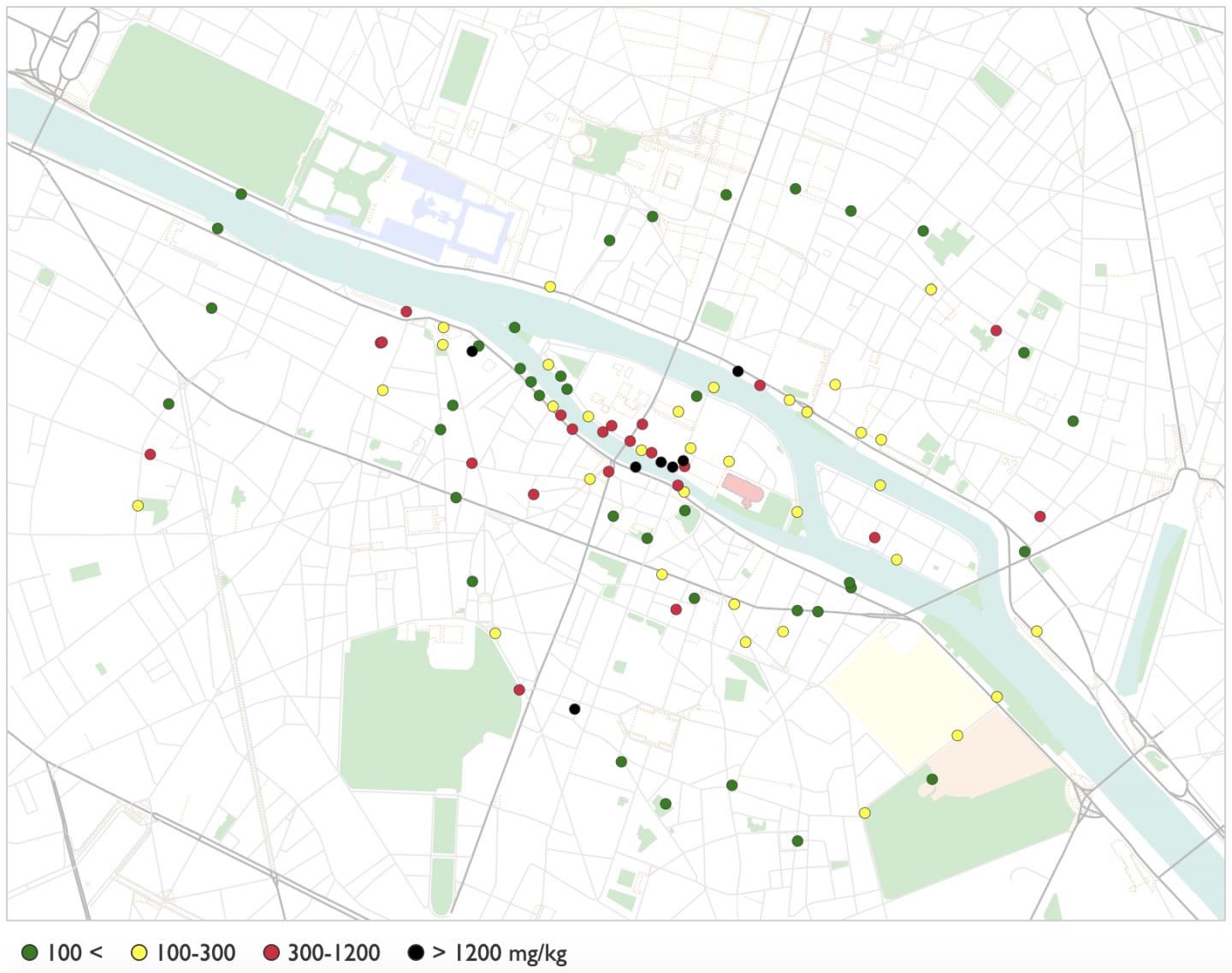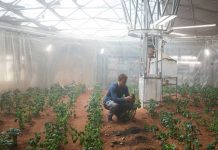
IMAGE: Soil samples taken in the vicinity of Notre Dame Cathedral show high levels of lead from the 2019 fire. An interactive version of this map, showing images of individual sample…
view more
Credit: Interactive map by Jeremy Hinsdale/Earth Institute. Photos by Alexander van Geen.
On April 15, 2019, the world watched helplessly as black and yellow smoke billowed from the Notre Dame cathedral in Paris. The fire started just below the cathedral’s roof and spire, which were covered in 460 tons of lead — a neurotoxic metal, dangerous especially to children, and the source of the yellow smoke that rose from the fire for hours. The cathedral is being restored, but questions have remained about how much lead the fire emitted into the surrounding neighborhoods, and how much of a threat it posed to the health of people living nearby.
A new study, published today in GeoHealth, used soil samples collected from neighborhoods around the cathedral to estimate local amounts of lead fallout from the fire. Lead levels in the soil samples indicated that nearly a ton of lead dust dropped down within one kilometer (0.6 miles) of the site, and areas downwind of the fire had double the lead levels than sites that were outside the path of the smoke plume. The study concludes that, for a brief time, people residing within a kilometer and downwind of the fire were probably more exposed to lead fallout than measurements by French authorities indicated.
Early evidence suggested that the fire increased lead exposure in Paris. Air quality measurements taken 50 kilometers away from the cathedral found that lead particulates in the air were 20 times higher than usual in the week after the fire. However, a small set of measurements by France’s Regional Health Agency, posted weeks after the fire, found that all the samples collected outside of the out-of-bounds area around the cathedral had lead levels below France’s limit of 300 milligrams per kilogram of soil. At the time, there were fears that the health agency was underplaying the potential health impacts and not being transparent enough.
“There was a controversy — were children being exposed or not from this fallout?” said Lex van Geen, a geochemist at Columbia University’s Lamont-Doherty Earth Observatory and lead author on the new study. “So I thought, whether I get a ‘yes’ or a ‘no,’ it’s worth documenting.”
In December 2019 and February 2020, van Geen collected 100 soil samples from tree pits, parks and other locations around the cathedral, and in particular to the northwest, where most of the smoke traveled on the day of the fire. When lead enters soil, it tends to stay put, so it can preserve the signal of the fallout for much longer than hard surfaces such as roads and sidewalks, which get swept and flushed by rain.
“It wasn’t a particularly glamorous expedition,” said van Geen. “I got plenty of strange looks from people wondering why this old guy was scooping up soil, trying to avoid the dog poop, and putting some of the soil in paper bags. But it got done.”
Non-contaminated soil would be expected to contain less than less than 100 milligrams of lead per kilogram of soil. However, in samples collected within a kilometer the cathedral’s remains, the levels averaged 200 mg/kg. And in the northwest direction downwind of the fire, the lead was significantly higher, averaging nearly 430 mg/kg — double that of the surrounding area, and surpassing France’s 300 mg/kg limit.
Because the sample sites weren’t uniformly distributed, co-authors Yuling Yao and Andrew Gelman from Columbia University’s Statistics Department used statistical methods to predict the overall distribution of lead, calculate the averages inside and outside of the plume, and estimate the total amount of lead that fell near the fire. By their calculations, 1,000 kilograms (2,200 pounds) of lead settled within a kilometer of the cathedral. That’s six times higher than the current estimate for the amount of lead fallout between 1 and 20 kilometers of the site.
“Our final estimation of the total amount of excess lead is much larger compared with what has been reported earlier by other teams,” said Yao. “Of course, we are measuring slightly different things, but ultimately all disagreement in scientific findings shall be validated by more data, especially when they have profound policy and public health consequences. I hope our work sheds some light in that direction.”
It is difficult to ascertain how this lead may have affected human health, because too few soil, dust, and blood samples were collected immediately after the fire, said van Geen. The impacts are likely much lower than those of leaded gasoline, which was entirely phased out by the year 2000. Nevertheless, lead could have posed a brief but significant health hazard to children living downwind of the fire.
On June 4, seven weeks after the fire, the French government made blood tests available at a local hospital on an on-demand basis. This only occurred after a child in a nearby apartment was found to have a concerning level of lead in their blood. (Subsequent investigation identified a different source of lead as the more likely culprit in this case.) Soil and dust tests were similarly delayed and limited in scope.
To van Geen, the government showed it had the means to respond but it didn’t do so quickly enough. He says that the urgency of the situation should have been more clearly conveyed with pro-active collection and posting of environmental and blood-lead data. This would have induced more parents downwind of the fire to remove indoor dust with wet wipes at home and prevent kids from playing in soil, thereby reducing their chances of exposure.
###
The paper,
‘Fallout of Lead over Paris from the 2019 Notre-Dame Cathedral Fire,’ can be obtained from the authors or [email protected]
Scientist contact:
Alexander van Geen: [email protected]
More information: Kevin Krajick, Senior editor, science news, The Earth Institute [email protected] 212-854-9729
Lamont-Doherty Earth Observatory is Columbia University’s home for Earth science research. Its scientists develop fundamental knowledge about the origin, evolution and future of the natural world, from the planet’s deepest interior to the outer reaches of its atmosphere, on every continent and in every ocean, providing a rational basis for the difficult choices facing humanity. http://www.
The Earth Institute, Columbia University mobilizes the sciences, education and public policy to achieve a sustainable earth. http://www.
TDnews














